Hiking along the Nooksack River in the Cascade Range around Mount Baker, Claude Zervas began to focus on campsites filled with burnt evidence of previous habitation.
One he carried home in his truck, rocks and all. Besides the usual shotgun shells, it contained the charred remains of an upholstered chair. Who burns a chair in a forest? Somebody too drunk to forage, too wet to plow.
Most of the camps Zervas saw were well made, dug deep and surrounded by rocks, but scattered like chickenpox scars on a lovely face, their careful construction could suggest that human damage can be contained in a pit, and that scars don’t affect the whole.
Claude Zervas, Black Hole, 2009
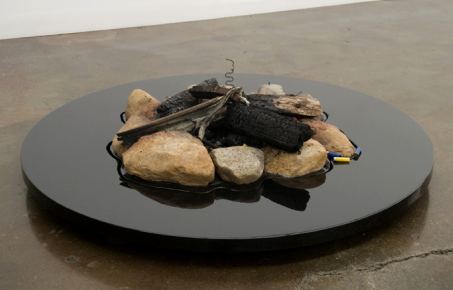 What is constructed, found and constructed again is the theme of From Whence The Rainbow Came at Ambach & Rice, featuring four of the Northwest’s top artists: Zervas, Joseph Park, Dan Webb and Jeffry Mitchell. It’s the best group show in a Seattle gallery in years, proposed and shaped by the artists themselves.
What is constructed, found and constructed again is the theme of From Whence The Rainbow Came at Ambach & Rice, featuring four of the Northwest’s top artists: Zervas, Joseph Park, Dan Webb and Jeffry Mitchell. It’s the best group show in a Seattle gallery in years, proposed and shaped by the artists themselves.
Zervas is an urban man whose heart is in what’s left of Northwest wilds.
Log and Beam, 2009. Made of paper, it wears the bark of a tree like a ball and chain, the real dragging down the illusion of the faked.
Veneer Sculpture, 2009
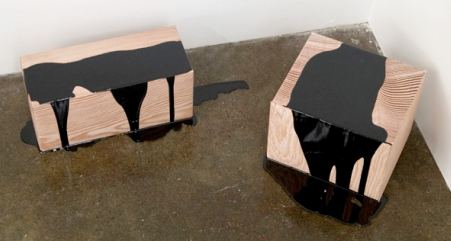
Leo Saul Berk should have been included in From Whence The Rainbow Came, not just because the group is really a gang of five but because Berk’s elaborations are important to the theme.
Leo Saul Berk, Ribbon, a peeled tree from 2001:
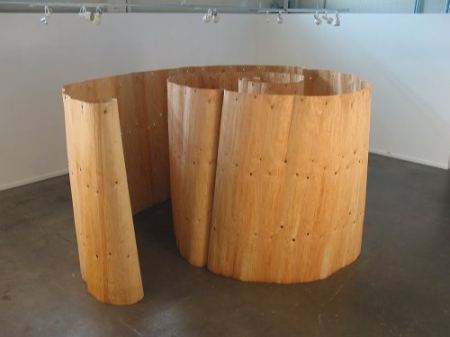 Zervas’ landscapes have roots in the land, but Park’s come from bad painting bins at second-hand stores.
Zervas’ landscapes have roots in the land, but Park’s come from bad painting bins at second-hand stores.
Joseph Park, eye of the tiger, oil/panel, 20 x 16 inches
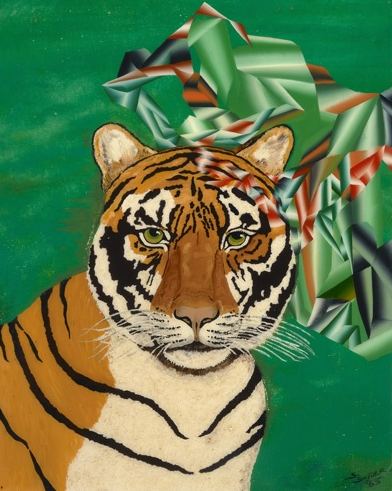 Plenty of artists root through these bins, but Park’s engagements are always transformative. In eye of the tiger,
Plenty of artists root through these bins, but Park’s engagements are always transformative. In eye of the tiger,
he sanded down heavy brush strokes and painted them over, giving his
surfaces a mute sheen. He stuck with the original’s overheated green
but added a half-halo of cracked color shards as a gaudy grace note.
Joseph Park, duck duck, 2009 oil/oil board mounted to panel, 6 x 8 inches.
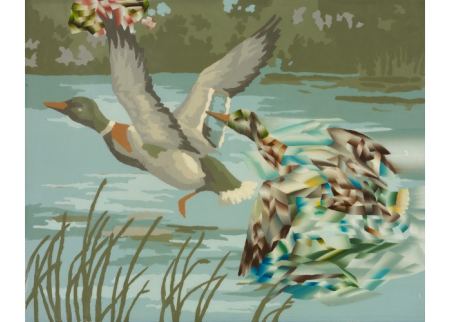 Park also offers a few paintings that do not derive from amateurs, such as the futurists, 2009, oil/panel, 24 x 30 inches. A John Singer Sargent family portrait gets Park’s version of futurist treatment.
Park also offers a few paintings that do not derive from amateurs, such as the futurists, 2009, oil/panel, 24 x 30 inches. A John Singer Sargent family portrait gets Park’s version of futurist treatment.
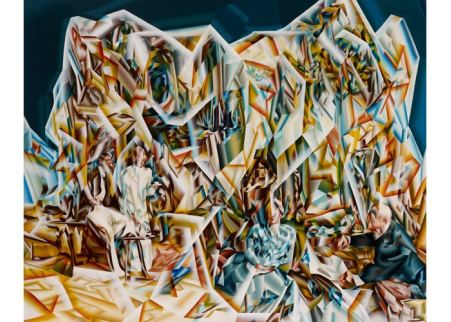 I’d like to see Park’s new work in an exhibit with mid-career Kenneth Callahan as well as choice samples of white writing from Mark Tobey and Morris Graves, with Susan Skilling, Michael Knutson and Joseph Goldberg.
I’d like to see Park’s new work in an exhibit with mid-career Kenneth Callahan as well as choice samples of white writing from Mark Tobey and Morris Graves, with Susan Skilling, Michael Knutson and Joseph Goldberg.
joining Park in the contemporary moment. White writing was the
Northwest’s version of Futurism. Futurism lives, but so does the
Northwest School.
And so does Picasso.
Joseph Park, picasso and bull, 2009, oil/panel, 36 x 24 inches.
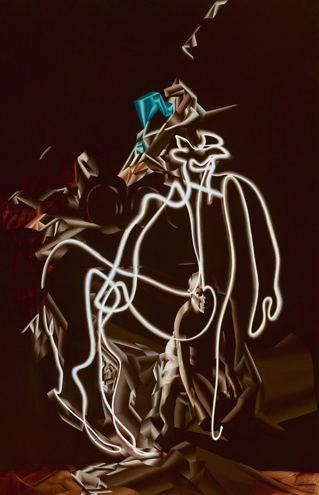 Park painted Picasso drawing on glass, which Picasso liked to do to amaze the multitude, example here.
Park painted Picasso drawing on glass, which Picasso liked to do to amaze the multitude, example here.
In
the early 20th-century battle between Duchamp and Picasso, Duchamp
represented mind, and Picasso mind in matter. For a time, Duchamp
handed Picasso his hat. By the 1970s, Duchamp dominated art discourse,
and Picasso’s name rarely came up.
What was true in the 1970s isn’t necessarily true now. Starting with artists such as Charles LeDray, whose roots are in the Northwest, makers are back in a big way.
Dan Webb, Fortress, carved cedar, 44 x 48 x 29
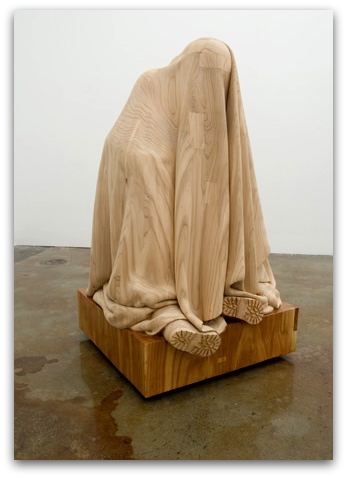 Two
Two
small boys crawl into a fort that collapsed into a confessional. Like
many childhood memories, the event is irretrievable. We become who we
are based on who we were, which is lost to us. What we have is a
constructed narrative, which is why Tom Robbins likes to say it’s never
too late to have a happy childhood.
Given a chance to roam
through museums, kids frequently stop at the Armour.Webb made his suit
of Armour in rawhide. It’s a giant chew toy, but it’s also a kind of
skin. Nobody could say this figure wears his nerves on the outside of
his body.
Dan Webb, Skin, 2009, rawhide, 72 x 34 x 22.
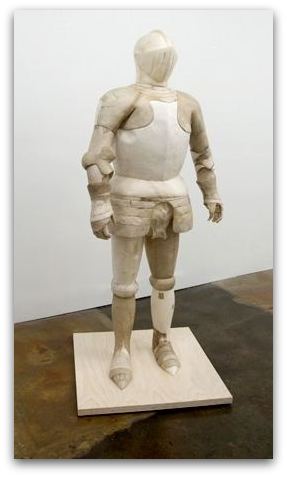 Back to Picasso. Do you recognize this figure?
Back to Picasso. Do you recognize this figure?
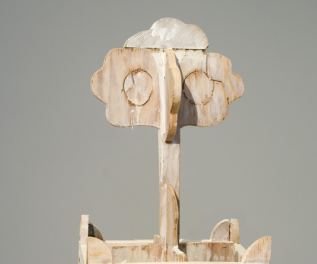 It’s Jeffry Mitchell’s tribute to the Spanish master, and it tops Mitchell’s partially painted sculpture titled White Weeds, 2009, made of wood, paper, plaster, string, porcelain, light bulbs, Plexiglas, gouache, pencil and epoxy enamel.
It’s Jeffry Mitchell’s tribute to the Spanish master, and it tops Mitchell’s partially painted sculpture titled White Weeds, 2009, made of wood, paper, plaster, string, porcelain, light bulbs, Plexiglas, gouache, pencil and epoxy enamel.
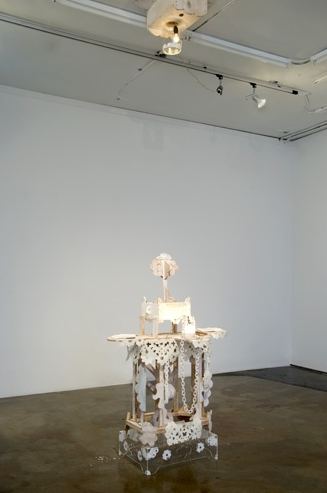 Detail:
Detail:
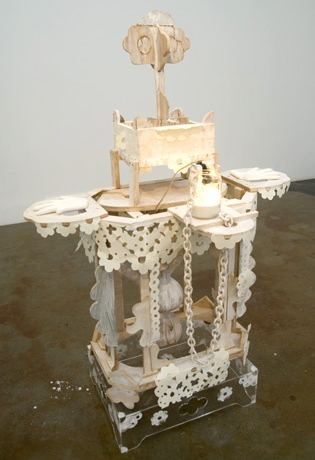 Detail:
Detail:
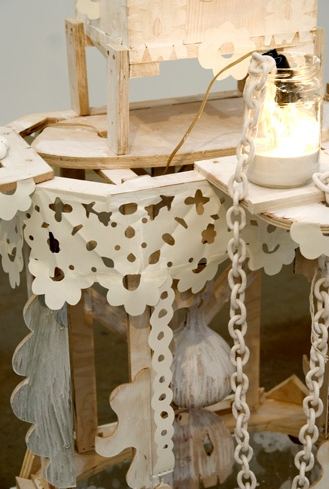
about your ancestors,” Theodore Roethke told a class of aspiring poets.
A student asked if Roethke meant ancestors or influences. “Just answer
the question,” he said.
White Weeds is Mitchell’s answer.
Both fluid and blunt, it’s Mitchell’s version of Picasso drawing on
glass as a means of sharing what he knows. There are tributes to
Picasso of course, but also to Giacomo Balla’s egg holder, to the idea
of whiteness as a whale (white whale, white elephant), to the white
fence Tom Sawyer tricked his friends into painting and to valentines
made by small hands for loved ones.
The Y’s on the sides allude to Yoko Ono’s Yes piece and the Beatles I Love You, Yeah, Yeah, Yeah, which Mitchell has previously made as flags and plates. He also makes pickle jars in porcelain. In White Weeds,
there are two real pickle jars in glass with a real light bulb, and
paper/porcelain/plaster chains, hands and hearts, the chains suggesting
an anchor at the bottom of the black sea, and a gourd for the balls it
takes to keep making art across a lifetime.
On the ceiling is
another light bulb, the Holy Ghost from the Trinity that Warhol painted
as the bird from a Dove Soap bar. Mitchell encloses his light in a
Babar-the-Elephant foot, a heavy thing that floats without weight.
Through Oct. 18.



Regina! Joseph Park has NOTHING to do with your precious Northwest School. Why should he carry its weight on his back? Bad idea. Bad. I’m grateful you’re not a curator. Otherwise, good piece.
Hello Stop-That-Critic. I proposed a white-writing exhibit, in which I think Park’s recent paintings have a role. Where is white-writing now? What’s wrong with that?
Jeffry Mitchell’s artworks knock me out. Sex, death, desire, love of the world, love of everybody in it.
Dan Webb is a sculptor of the tragic, and Joe Park paints like a god. Jeffery Mitchell is Picasso if Picasso was all about the love. Nobody has as original approach to the NW landscape as Claude Zervas. It’s weird that Claude had a show a few months ago at his gallery, James Harris Gallery. None of this work was there. There were only the strings of lights and light boxes. Seattle doesn’t have a lot of real galleries to choose from. JH is the best. I’d love to be in his gallery, so I can’t sign my name here. But JH needs to give the artists he represents more freedom. I don’t know what Zervas thinks. I barely know him and I haven’t asked. I haven’t asked JH either. I only say nice things to him. I’m a suckup, but I have a master plan. I’d love to be at Greg Kucera too, Howard House or Platform. Lawrimore Project is fine for installation, video and architecturally inclined artists, but my work would die in there. I hate his front gallery. It’s a cave.
All four of these artists are at Ambach & Rice? No wonder you called it an empire.
A&R’s real drawback is the location. Ballard? Really? Do we HAVE to? There are plenty of vacant spaces in Pioneer Square these days. Why, why, WHY do we have to make things more complicated for out-of-towners? Tourists do actually walk in a buy things sometimes. What were you planning for your visitors? A gallery tour with a stop-off at Canlis?
I hear you on Ballard, Husky Quaker, and I think the gallery is moving next year, I hope closer to Pioneer Square. The one-stop shop concept works for me.
Hi Alfred. Only Jeffry Mitchell made the move to A& R. Claude Zervas continues to be represented by James Harris, Dan Webb by Greg Kucera and Joseph Park by Rena Bransten.
They’re such a boy’s club. No girls allowed.
Feminist Artist: If you need a Girls Club, why don’t you join SOIL or Gallery 110?
Soil: 13 girls, 6 boys
Gallery 110: 20 girls, 8 boys
It means something that Zervas had a recent show at his regular gallery and none of his recent work was in it. Thank you Ambach & Rice for letting these artists be themselves. The rest of you Seattle galleries need to do the same. If you don’t let artists take risks, you damage them.
Dear Feminist Artist: Do you use quotas in your friendships? How many of your friends are differently-abled if you’re regularly abled, of color or white if you’re not? How many are porky if you’re thin? Pretty if you’re a hag?… (Deleted by editor)… I’m a feminist, Feminist Artist. You’re jealous.